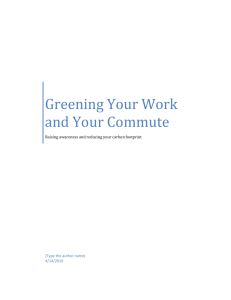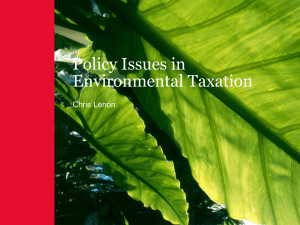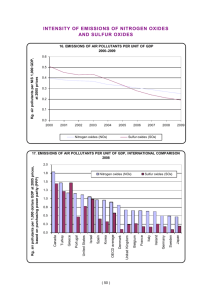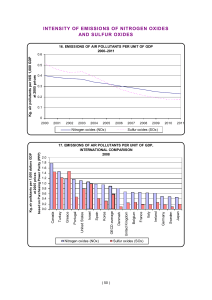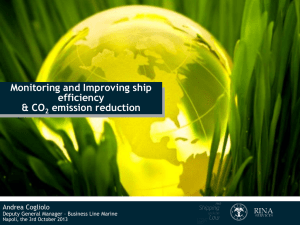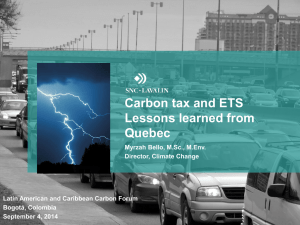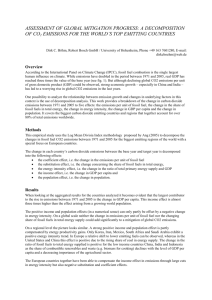Merven, B: Energy systems modeling at ERC: The SA TIMES model
advertisement
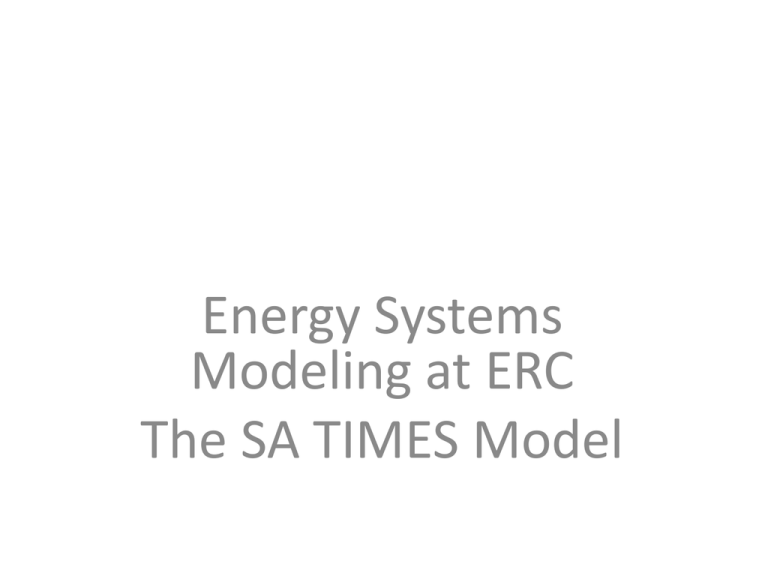
Energy Systems Modeling at ERC The SA TIMES Model Overview of Modeling Demand Sectors (commercial and agriculture omitted from diagram) Energy Resources/Import and Exports Import/export (elc, oil, gas) Renewable energy resource potential Fossil fuel reserves Supply Technology Future coal/gas supply technologies Future liquid fuel supply technologies Future power generation technologies Existing coal/gas supply system Existing liquid fuel supply system Existing power system Base Year Energy Balance MARKAL/TIMES optimization energy model (GAMS with CPLEX solver) Residential sector future technologies Industrial sector future technologies Transport sector future technologies Residential sector baseyear calibration Industrial sector base-year calibration Transport sector baseyear calibration Residential sector Demand projections Industrial sector Demand projections Transport sector Demand projections Economic Analysis Policy objectives/constraints Energy security objectives Environmental objectives, taxes Socio-economic growth objectives Socio-Economic Variables (GDP, Population) Results Analysis Inputs to optimization model Outputs from optimization model Intermediary information flow Investment Schedule/Plan Imports, exports, consumption, production, Emissions System costs, energy costs Components of a MARKAL/TIMES model Components of an Energy System Model * Energy system topology & organization RES 150 125 * Numerical data 100 Time Series G 75 W50 h 25 0 1970 * Mathematical structure – transformation equations – bounds, constraints – user defined relations * Scenarios and strategies 1975 1980 1985 1990 1995 2000 2005 2010 2015 2020 PBHKW _ S BHKW PCoal _ BHKW OBHKW _ CO PCoal _ BHKW 2 QBHKW _ H 2 _ BHKW PCoal _ BHKW GAMS Model Cases Simple Reference Energy System Energy model components • Made up of 2 simple components: – Energy Carriers (e.g. fuels, demand) – Technologies (e.g. Light bulb, power plant) all characterized in the same way: – – – – – – – – Input and Output Carrier Efficiency Investment Costs per unit of capacity Annual Activity Costs Existing Capacity Annual Availability Expected Life Emissions Useful energy demand • Calculated using spreadsheets • Based on assumptions – Useful energy calculated for base year – Projected into future • Affected by – – – – GDP assumptions Structure of the economy Changes in per capita income Assumed income distribution, electrification etc Sectors Sector Disaggregation Driver Agriculture By end use, irrigation, transport etc Agriculture GDP Residential High, medium and low income/ electrified and non-electrified POPULATION, Household income By end use, cooking, lighting etc Commercial By end use, lighting, HVAC, etc Commercial GDP, building stock Industrial By sector, Iron and Steel, Pulp and paper etc Sectoral GDP By end use, thermal fuel or electricity (compressed air, cooling, motive, etc Transport Air, Freight, passenger, pipeline By end demand, passenger km, ton km By end use, diesel car, petrol car, taxi etc Transport GDP, Population and household income Variation of the Load (electricity) • • • • 20 Time-slices Year divided in 3 seasons Each season represented by 2 typical days Season 1 and 3 (summer), each day is broken up into 3 parts (night, day, evening) • Season 2 (winter) week day is broken up into 5 parts (night, morning, afternoon, evening, peak) Other elements • Emissions: – Emissions coefficient/energy carrier – Emissions Tax • Constraints: – – – – – Committed build plans Resource limits Mode shares Fuel shares Policy Objectives (e.g. CO2 limit) Model Outputs • Reported globally: – – – – Total Costs Total tax/subsidy Total Investments … • Reported for demands each year: – Actual energy demand met – Marginal Price (Shadow price/cost of supplying one extra unit of demand) • Reported for each energy carrier each year: – Imported/exported – Mined Model Outputs (Continued) • Reported for technologies each year: – – – – – – – Fixed costs Capacity Level and Marginal Capacity Unused Fuel Used Investment Costs Investment Levels and Marginal costs … • Reported for emissions each year: – Emission Levels • Reported for tax/subsidy each year: – Tax/Subsidy The SAGE Model • Calibrated to a 2005 SAM (Arndt et al., 2011) – 54 industries and 46 commodities – 7 factors of production (4 education-based labour groups; energy and nonenergy capital; agricultural productive land) – 14 household groups based on per capita expenditures – Energy Supply Sector disaggregated • Resource constraints – Upward sloping labour supply curves for less-educated workers – Sector Specific capital and endogenous capital accumulation • Macroeconomic closures – Fixed current account with flexible real exchange rate – Savings-driven investment • Model has already been used by Treasury to look at some CO2 tax scenarios and recycling options SAGE Model (continued) • Previous Runs of SAGE model with Power sector production shares and investment The CGE-TIMES Link - Simple Extrapolation of sectoral and income growth, used to recalculate useful energy demand. -GDP and sectoral growth -Household income growth - Electricity Generation Shares - Investment - [Electricity production costs] Sectoral Linkage The CGE-TIMES link continued • • • • • The Idea is to replicate IRP/IEP process in TIMES Fix committed build See how the economy responds Adjust forecast and update investment plans Re-iterate


